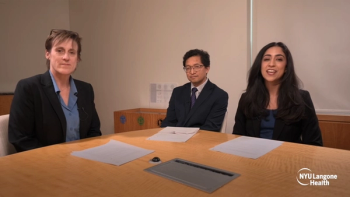
Controlling glaucoma may be all about health
According to Alyson Hall, MD, factors can include vascular dysregulation, oxidative stress, autoimmunity and cytotoxicity.
Intraocular pressure (IOP) lowering in glaucoma is almost at the level of an art; however, despite IOPs around 10 mm Hg as the result of medical and surgical approaches, glaucoma continues to progress in about half of patients, and Alyson Hall, MD, who is in private practice in Bowie, Maryland, discussed other factors and the importance of overall health in this patient population.
“Lowering the IOP is the only proven treatment available,” she said. “However, numerous other factors can be involved in glaucoma.”
These include vascular dysregulation, oxidative stress, autoimmunity, and c autoimmunity ytotoxicity. Hall advises patients to adopt lifestyle changes that may help prevent progression of glaucoma. While no large studies have that suggested that these factors are involved in glaucoma prevention, some evidence has suggested the beneficial effects of factors such as healthy diets, well-controlled blood pressure, and exercise may help prevent progression, she explained.
Impact of diet on glaucoma
Diet, she noted, can have a positive effect both on IOP and the incidence and progression of glaucoma.
“Patients who are obese have oxidative stress in the body and eyes and dysregulation of blood flow,” Hall noted. “In addition, increased orbital fat impedes aqueous outflow. Maintaining a healthy weight is important.”
As an example, in patients with age-related macular degeneration, use of antioxidants helps to reduce the incidence and progression of the disease.
“Anything that is good for the heart is good for the eyes,” Hall commented.
Vitamins A and C were shown to reduce the incidence of progression to glaucoma in women.1,2
Nitric oxide, present in green leafy vegetables, is also important in decreasing the development of glaucoma.3
High alcohol intake has the opposite effect as seen in the Framingham Eye Study because it was positively associated with development of glaucoma.4 In contrast, low to moderate alcohol intake may exert a protective effect. Caffeine may stimulate aqueous production and cause transient increases in IOP, though no link to glaucoma has been established. Tea may decrease oxidative stress and increase blood flow, and patients who drink it daily are less likely to have glaucoma.5,6
Blood pressure and glaucoma
Arterial blood pressure has been shown to cause damage to the optic disc over time. Duke University investigators reported that eyes with a lower mean arterial and arterial diastolic pressures had faster rates of retinal nerve fiber layer loss.7
Hall pointed out that in patients with low blood pressure, there is compensatory vascoconstriction, while high blood pressure may result in atherosclerosis.
“Both scenarios impair blood flow,” she said. “The patients with nocturnal hypotension tend to do worse.”
Hall also advised clinicians to consult with patients’ cardiologists and primary care physicians regarding the appropriate levels of medication. Twenty-four hour blood pressure monitoring may be useful to identify patients with extreme differences in blood pressure values.
Exercise in glaucoma
Physical activity positively affects ocular perfusion and IOP that is dependent on the intensity and duration of the exercise, with the intensity reported to be the more important factor,8 Hall said.
Some situations require caution, eg, intensive exercise can cause IOP increases in patients with pseudoexfoliation glaucoma, and goggles worn during swimming can increase IOP in normotension glaucoma. Interestingly, masks worn during scuba diving do not negatively affect the IOP. However, diving can increase the rate of progression of glaucoma.
Patients who practice yoga should be advised to avoid the head-down postures.
“Inversion increases the episcleral venous pressure and increases the choroidal thickness,” Hall said.
Engaging in exercise also up-regulates neurotrophic expression, thus enhancing mitochondrial function and possibly decreasing inflammation in patients with glaucoma.
“Maintaining a healthy diet is important,” Hall concluded. “Keeping the blood pressure within the normal range and exercising can decrease glaucoma progression and enhance patients’ quality of life.”
This article was adapted from Hall’s presentation at the American Society of Cataract and Refractive Surgery’s annual meeting, held recently in Washington, DC. She has no financial interest in this subject matter.
References
- Coleman AL, Stone KL, Kodjebacheva G, et al. Glaucoma risk and the consumption of fruits and vegetables among older women in the study of osteoporotic fractures. Am J Ophthalmol 2008;145:1081-9.
- Giaconi JA, Yu F, Stone KL, et al. The association of consumption of fruits/vegetables with decreased risk of glaucoma among older African-American women in the study of osteoporotic fractures. Am J Ophthalmol 2012;154:635-44.
- Kang JH, Willett WC, Rosner BA, et al. Association of dietary nitrate intake with primary open angle glaucoma: a prospective analysis from the nurse’s health study and health professionals follow-up study. JAMA Ophthalmol 2016;134:294-303.
- Kahn HA, Milton RC. Alternative definitions of open-angle glaucoma. Effect on prevalence and associations in the Framingham Eye Study. Arch Ophthalmol 1980;98(12):2172-7.
- Jiwani AZ, Rhee, DJ, Brauner SC, et al. Effects of caffeinated coffee consumption on intraocular pressure, ocular perfusion pressure, and ocular pulse amplitude: a randomized controlled trial. Eye (Lond) 2012;26:1122-30.
- Maher P, Hanneken A. Flavonoids protect retinal ganglion cells from oxidative stress-induced death. Invest Ophthalmol Vis Sci 2005;46:4796-803.
- Jammal AA, Berchuck SI, Mariottoni EB, et al. Blood pressure and glaucomatous progression in a large clinical population. JAMA Ophthalmol 2022;129:161-70; doi: 10.1016/j.ophtha.2021.08.021.
- Qureshi IA. The effects of mild, moderate and severe exercise on intraocular pressure in glaucoma patients. Jpn J Physiol 1995;45:561-9.
Newsletter
Don’t miss out—get Ophthalmology Times updates on the latest clinical advancements and expert interviews, straight to your inbox.













































